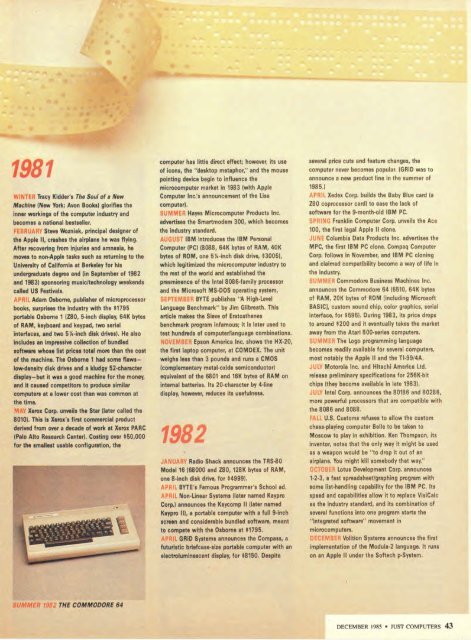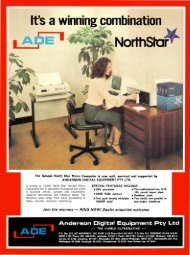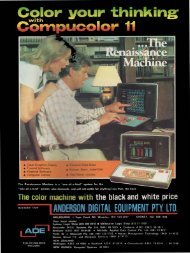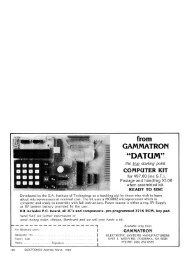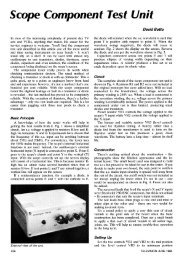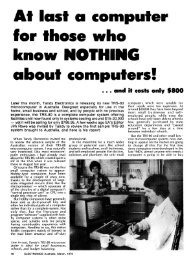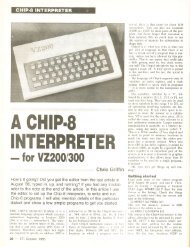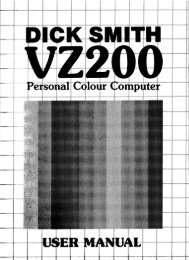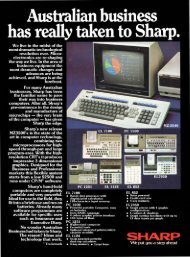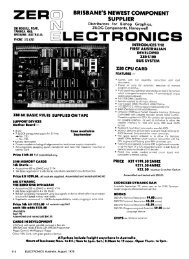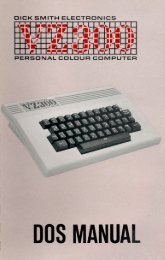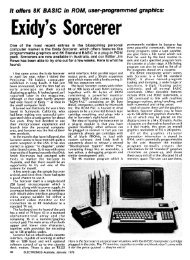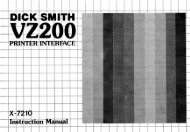History of Micro-Computers - The MESSUI Place
History of Micro-Computers - The MESSUI Place
History of Micro-Computers - The MESSUI Place
You also want an ePaper? Increase the reach of your titles
YUMPU automatically turns print PDFs into web optimized ePapers that Google loves.
Tracy Kidder's <strong>The</strong> Soul <strong>of</strong> a NewMachine (New York: Avon Books) glorifies theinner workings <strong>of</strong> the computer industry andbecomes a national bestseller.Steve Wozniak, principal designer <strong>of</strong>the Apple II, crashes the airplane he was flying.After recovering from injuries and amnesia, hemoves to non-Apple tasks such as returning to theUniversity <strong>of</strong> California at Berkeley for hisundergraduate degree and (in September <strong>of</strong> 1982and 1983) sponsoring music/technology weekendscalled US Festivals.Adam Osborne, publisher <strong>of</strong> microprocessorbooks, surprises the industry with the $1795portable Osborne 1 (Z80, 5-inch display, 64K bytes<strong>of</strong> RAM, keyboard and keypad, two serialinterfaces, and two 51/4-inch disk drives). He alsoincludes an impressive collection <strong>of</strong> bundleds<strong>of</strong>tware whose list prices total more than the cost<strong>of</strong> the machine. <strong>The</strong> Osborne 1 had some flawslow-densitydisk drives and a kludgy 52-characterdisplay—but it was a good machine for the money,and it caused competitors to produce similarcomputers at a lower cost than was common atthe time.Xerox Corp. unveils the Star (later called the8010). This is Xerox's first commercial productderived from over a decade <strong>of</strong> work at Xerox PARC(Palo Alto Research Center). Costing over $50,000for the smallest usable configuration, thecomputer has little direct effect; however, its use<strong>of</strong> icons, the "desktop metaphor," and the mousepointing device begin to influence themicrocomputer market in 1983 (with AppleComputer Inc.'s announcement <strong>of</strong> the Lisacomputer).Hayes <strong>Micro</strong>computer Products Inc.advertises the Smartmodem 300, which becomesthe industry standard.IBM introduces the IBM PersonalComputer (PC) (8088, 64K bytes <strong>of</strong> RAM, 40Kbytes <strong>of</strong> ROM, one 51/4-inch disk drive, $3005),which legitimized the microcomputer industry tothe rest <strong>of</strong> the world and established thepreeminence <strong>of</strong> the Intel 8086-family processorand the <strong>Micro</strong>s<strong>of</strong>t MS-DOS operating system.BYTE publishes "A High-LevelLanguage Benchmark" by Jim Gilbreath. Thisarticle makes the Sieve <strong>of</strong> Eratosthenesbenchmark program infamous; it is later used totest hundreds <strong>of</strong> computer/language combinations.Epson America Inc. shows the HX-20,the first laptop computer, at COMDEX, <strong>The</strong> unitweighs less than 3 pounds and runs a CMOS(complementary metal-oxide semiconductor)equivalent <strong>of</strong> the 6801 and 16K bytes <strong>of</strong> RAM oninternal batteries. Its 20-character by 4-linedisplay, however, reduces its usefulness.Radio Shack announces the TRS-80Model 16 (68000 and Z80, 128K bytes <strong>of</strong> RAM,one 8-inch disk drive, for $4999).BYTE's Famous Programmer's School ad.Non-Linear Systems (later named KayproCorp.) announces the Kaycomp II (later namedKaypro II), a portable computer with a full 9-inchscreen and considerable bundled s<strong>of</strong>tware, meantto compete with the Osborne at $1795.GRiD Systems announces the Compass, afuturistic briefcase-size portable computer with anelectroluminescent display, for $8150 Despiteseveral price cuts and feature changes, thecomputer never becomes popular. (GRID was toannounce a new product line in the summer <strong>of</strong>1985.)Xedex Corp. builds the Baby Blue card (aZ80 coprocessor card) to ease the lack <strong>of</strong>s<strong>of</strong>tware for the 9-month-old IBM PC.SPRINC, Franklin Computer Corp. unveils the Ace100, the first legal Apple II clone.Columbia Data Products Inc. advertises theMPC, the first IBM PC clone. Compaq ComputerCorp. follows in November, and IBM PC cloningand claimed compatibility become a way <strong>of</strong> life inthe industry.Commodore Business Machines Inc.announces the Commodore 64 (6510, 64K bytes<strong>of</strong> RAM, 20K bytes <strong>of</strong> ROM [including <strong>Micro</strong>s<strong>of</strong>tBASIC), custom sound chip, color graphics, serialinterface, for $595). During 1983, its price dropsto around $200 and it eventually takes the marketaway from the Atari 800-series computers.<strong>The</strong> Logo programming languagebecomes readily available for several computers,most notably the Apple II and the TI-99/4A.Motorola Inc. and Hitachi America Ltd.release preliminary specifications for 256K-bitchips (they become available in late 1983).Intel Corp. announces the 80186 and 80286,more powerful processors that are compatible withthe 8086 and 8088.U.S. Customs refuses to allow the customchess-playing computer Belle to be taken toMoscow to play in exhibition. Ken Thompson, itsinventor, notes that the only way it might be usedas a weapon would be "to drop it out <strong>of</strong> anairplane. You might kill somebody that way."Lotus Development Corp. announces1.2-3, a fast spreadsheet/graphing program withsome list-handling capability for the IBM PC, Itsspeed and capabilities allow it to replace VisiCalcas the industry standard, and its combination <strong>of</strong>several functions into one program starts the"integrated s<strong>of</strong>tware" movement inmicrocomputers,Volition Systems announces the firstimplementation <strong>of</strong> the Modula-2 language. It runson an Apple II under the S<strong>of</strong>tech p-System.THE COMMODORE 64DECEMBER 1985 • JUST COMPUTERS 43


